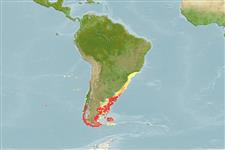Elasmobranchii (hajar och rockor) (sharks and rays) >
Carcharhiniformes (Ground sharks) >
Atelomycteridae (Coloured catsharks)
Etymology: Schroederichthys: In honor of American ichthyologist William C. Schroeder (1895-1977), Woods Hole Oceanographic Institution, for his pioneering work (with Henry B. Bigelow) on cartilaginous fishes; ichthyos (Gr.), fish. (See ETYFish); bivius: bi-, from bis (L.), two; via (L.), way or passage, etymology not explained, perhaps referring to double-valved nostrils, with incurrent and excurrent apertures. (See ETYFish).
More on authors: Müller & Henle.
Environment: milieu / climate zone / depth range / distribution range
Ekologi
marina bottenlevande; djupintervall 14 - 78 m (Ref. 244). Subtropical; 23°S - 56°S
Southeast Pacific and Southwest Atlantic: central Chile to the Straits of Magellan and Argentina.
Length at first maturity / Size / Vikt / Age
Maturity: Lm ?, range 40 - ? cm
Max length : 70.0 cm TL hane/ej könsbestämd; (Ref. 244)
A common inshore to offshore shark found on the continental shelf. Oviparous (Ref. 50449). Dental sexual dimorphism exists, with adult males having teeth at least twice as high as adult females as well as much longer and narrower mouths.
Life cycle and mating behavior
Maturities | Reproduktion | Spawnings | Egg(s) | Fecundities | Larver
Oviparous, paired eggs are laid. Embryos feed solely on yolk (Ref. 50449). Sexual dimorphism is evident in dentition of male species (Ref. 49562). Males have longer teeth with fewer cusps than females (Ref. 51093) to make 'courtship biting' more effective (Ref. 49562).
Compagno, L.J.V., 1984. FAO Species Catalogue. Vol. 4. Sharks of the world. An annotated and illustrated catalogue of shark species known to date. Part 2 - Carcharhiniformes. FAO Fish. Synop. 125(4/2):251-655. Rome: FAO. (Ref. 244)
IUCN Red List Status (Ref. 130435)
Threat to humans
Harmless
Human uses
Fiskeri: saknar intresse
Verktyg
Special reports
Download XML
Internet-källor
Estimates based on models
Preferred temperature (Ref.
123201): 6.4 - 15.6, mean 10.6 °C (based on 202 cells).
Phylogenetic diversity index (Ref.
82804): PD
50 = 0.5312 [Uniqueness, from 0.5 = low to 2.0 = high].
Trofisk nivå (Ref.
69278): 3.8 ±0.3 se; based on diet studies.
Resiliens (Ref.
120179): Mycket låg, lägsta populationsfördubblingstid mer än 14 år (Fec=2).
Fishing Vulnerability (Ref.
59153): Moderate to high vulnerability (48 of 100).
Nutrients (Ref.
124155): Calcium = 27.1 [4.5, 147.7] mg/100g; Iron = 0.723 [0.192, 2.131] mg/100g; Protein = 16.1 [13.3, 20.4] %; Omega3 = 0.18 [0.08, 0.39] g/100g; Selenium = 19.3 [5.8, 54.7] μg/100g; VitaminA = 10.6 [3.7, 29.9] μg/100g; Zinc = 0.636 [0.303, 1.164] mg/100g (wet weight); based on
nutrient studies.
